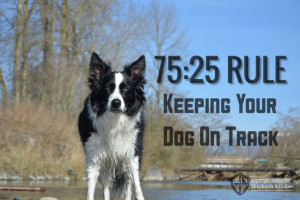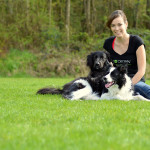Seventy Five Twenty Five
Seventy Five Twenty Five: Keeping Your Dog on Track

Herding breeds are unlike any other dog breed, for specific reasons. They’re bred:
- to be sensitive
- to work extremely close with the handler
- to be smart and use independent thinking
When we have a dog that has these amazing qualities, we want to make sure we don’t do things wrong, otherwise we can create quite the monster dog.
So what is seventy five twenty five? It’s a rule that I live by and I encourage all my clients to follow as well, especially when you have a working breed that was MEANT to work with the handler. Seventy five twenty five is the ratio of who/what your dog spends his time with - 75% should be with you, the handler/owner and 25% should be with the environment, other dogs, and other people. Now, there are some tidbits of information you need to know before applying this rule for it all to make sense.
Puppies
This rule does not fully apply to puppies under the age of six months because this is a crucial socialization time for them. Your puppy should be playing with other people from 8 -12 weeks and playing with other puppies and gentle, well socialized adult dogs from 3 months – 6 months old. This critical period in your dog’s life will shape them for the rest of their lives, so if you keep them away from positive experiences with people and dogs, they will become socially handicapped for the rest of their lives.
Socialization with your puppy should ideally be done in a controlled environment where either yourself or a professional can read canine body language and know when to step in or quickly counter condition if by chance things get a little “too much” for the pup. Never should you go to a puppy class and be separated from your puppy - this is BAD and can cause severe stress and that stress will be associated with what is around your pup (other people and puppies).
During this puppyhood, you will be a part of every social situation with your dog to help comfort him if he becomes nervous or scared, and to encourage and coax a shy puppy, making sure never to force.
Adolescence
This is the time where we know the dog is socialized, super happy when it meets dogs, people, kids etc. So at this time we can reel in all that freedom to do what the puppy wanted to and start to really apply a good training routine. This is where the 75/25 rule comes in.
75/25 Rule
Majority of your outings should now be focused on more one-on-one time, and paying lots of attention to what your dog is doing and what we want them to do. By taking your dog to a dog park for one hour, the majority of time spent there is with other dogs (not a bad thing) but if 95% of the time is ignoring you and playing with other dogs, you are ultimately teaching your dog that paying attention to other dogs and doing what they do is the thing to do and it’s awesome. By constantly allowing your dog to do this, you will have a very difficult time in the long run to get your dog to listen to you, coming when called, following you, to name the most common problems, because he will not know how good it is.
“All your dog knows right now is being with everything
else is so much more exciting than you are.”
Of course they can have a trip to the dog park (if you choose) or to a dog friend’s house/playdate once or twice a week and allow them to focus a majority of their attention on the dog, but this should be a small portion of your week 1:7 or 2:7 (days).
When you go out with your dog, their attention should be 75% on you, 25% on the environment or other stimuli in the environment.
Let’s give some examples below.
Example 1 - Going for a walk
Most people will just head out and go for a walk with their dog, ignoring them for the majority of the walk, don’t waste this opportunity of one-on-one time with your dog. While on your walk, asking your dog for known cues or involving them to engage with inanimate objects for 75% of the walk is a great way for your dog to get exercise and utilize his brain, all while listening to you. For 25% of the walk, let him sniff and do his own thing.
Example 2 – Open fields (1 hour outing)
Many of us take our dogs to school grounds or other open areas where you chuck a ball or walk around letting your dog interact with other dogs, people, sniff. Start incorporating a game when you’re at the field for 75% (45 minutes) of the time you’re there. Bring treats and train, play a game of find the toy, and engage him or her to play on the playground (if there is one). Then take that other 25% (15 minutes) you’re there and let the dog do what they want. If there is another dog there, let him play, or if your dog is into sniffing, let him sniff to his heart’s content for 25% of time.
Start re-thinking about where you take your dog and what environments are going to draw him away from you or keep him more focused on you. Pick the latter half and avoid areas where the dog won’t want to pay attention to you. We always look for easy ways to exercise our dogs, especially if we’ve had a long day at work, but you can easily set both of you up to succeed by knowing how much time should ideally be spent with you while outside.
Article By:
Kris Crestejo, CDBC
Meet our Evangelist







